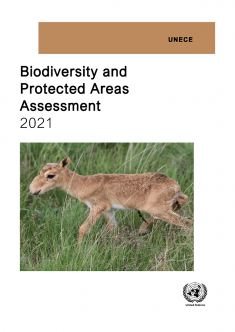This assessment was conducted between 18 June 2020 and 3 June 2021 with the objective of analyzing the developments and challenges in the management of biodiversity and protected areas (PAs) in 14 countries that carried out and completed a ECE Environmental Performance Review (EPR) under its 3rd cycle (further 3EPR) since 2014. This includes Albania (2018), Belarus (2016), Bosnia and Herzegovina (2018), Bulgaria (2017), Georgia (2016), Kazakhstan (2019), Republic of Moldova (2014), Mongolia (2018), Montenegro (2015), Morocco (2014), North Macedonia (2019), Serbia (2015), Tajikistan (2017), and Uzbekistan (2020). In the cases of Mongolia and Morocco, the “3EPR” acronym relates to the fact that their first EPRs were carried out according to the methodology of the third cycle of ECE EPRs. Moreover, the draft 3EPR report of Romania (carried out in 2020/21) has also been analyzed for this assessment.
The main objectives of this assessment were to:
• Examine what has been done in the management of biodiversity and PAs;
• Investigate challenges and bottlenecks encountered by countries;
• Identify trends and commonalities in areas of concern and in solutions to address them;
• Identify lessons learned and good practices in improving the management of biodiversity and PAs;
• Foresee possible matters of contention in the management of biodiversity and PAs for the next decade.
Highlights of developments and challenges in selected beneficiary countries of the UNECE EPR Programme, based on the results of the assessment “Biodiversity and protected areas assessment”:
- The existence of officially adopted strategies and programmes with detailed actions are prerequisites for addressing biodiversity loss. Conversely, the lack of a policy framework indicates the lack of political commitment. 12 out of 15 countries reviewed under the UNECE EPR Programme in the period 2014–2020/21 had National Biodiversity Strategies and Action Plans (NBSAPs). Most countries had a policy document on strengthening their protected area networks. Only 3 countries had a national wetlands policy.
- Ensuring coherence between the NBSAPs with other biodiversity-related strategies and, most importantly with strategies in the economic sectors, is crucial for an effective and comprehensive action on biodiversity conservation. Often NBSAPs are not consistent with other national policy strategies in the environment area and in various economic sectors.
- Adequate implementation of NBSAPs and other biodiversity-related policies is often lagging behind, making them declarative rather than operational frameworks. Even in countries with NBSAPs and other policies in place, the implementation of action on the ground is either insufficient, delayed or lacking.
- The implementation of the adopted strategies, programmes and plans is rarely monitored and their effectiveness is rarely evaluated, which is a crucial step before elaborating subsequent or new policies and actions, including new NBSAPs. One good practice observed was inscribing the reporting on NBSAPs in a country’s law on nature protection. That law requires the ministry responsible for ecology to report on measures undertaken, analyze progress based on performance indicators and consider possible improvements.
- The lack of credible data resulting from regular biodiversity monitoring is always a serious obstacle for sound and informed policy formulation. The absence of biodiversity monitoring, and thus of data, can seriously hamper evaluation of the effectiveness of strategies, programmes and plans. Unfortunately, costly and resource demanding as it is, biodiversity is often the weakest area in environmental monitoring. Forging partnerships to start bridging the monitoring gap, for example, with academia and civil society, is valuable.
- Cooperation with and active involvement of ministry in charge of the economy is a prerequisite in making successful the biodiversity conservation efforts. When reviewing biodiversity policies and actions, cooperation is identified between the ministries and agencies in charge of the environment, forestry, protected areas and occasionally agriculture. Ministries in charge of the economy are absent from biodiversity conservation partnerships, whilst they need to become key partners for an effective action at national level.
Thus, the existence of comprehensive policy, the effective and timely implementation of policy, the monitoring of policy and of biodiversity itself, and the coherence of policy across the economy are vital actions to stop and reverse biodiversity loss.


